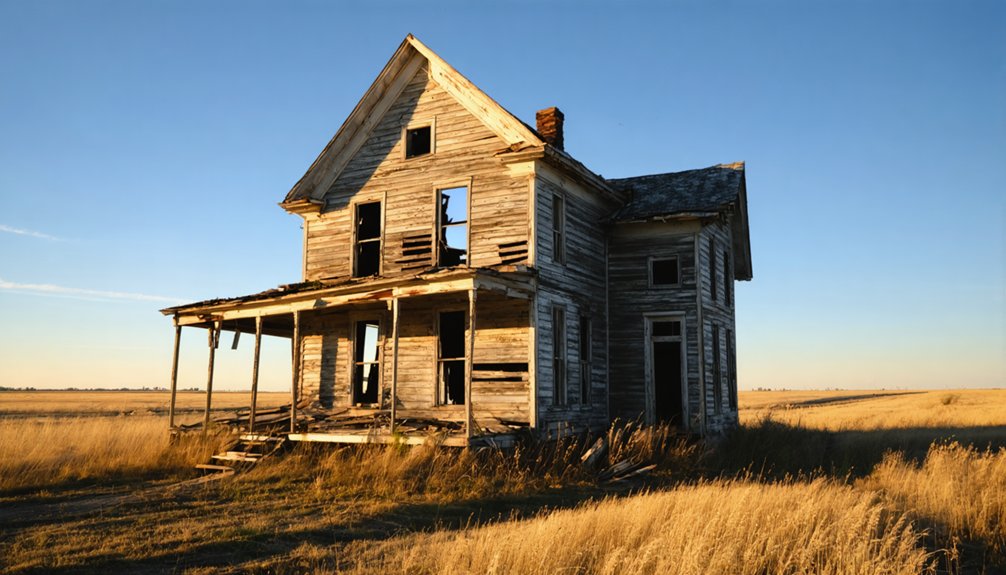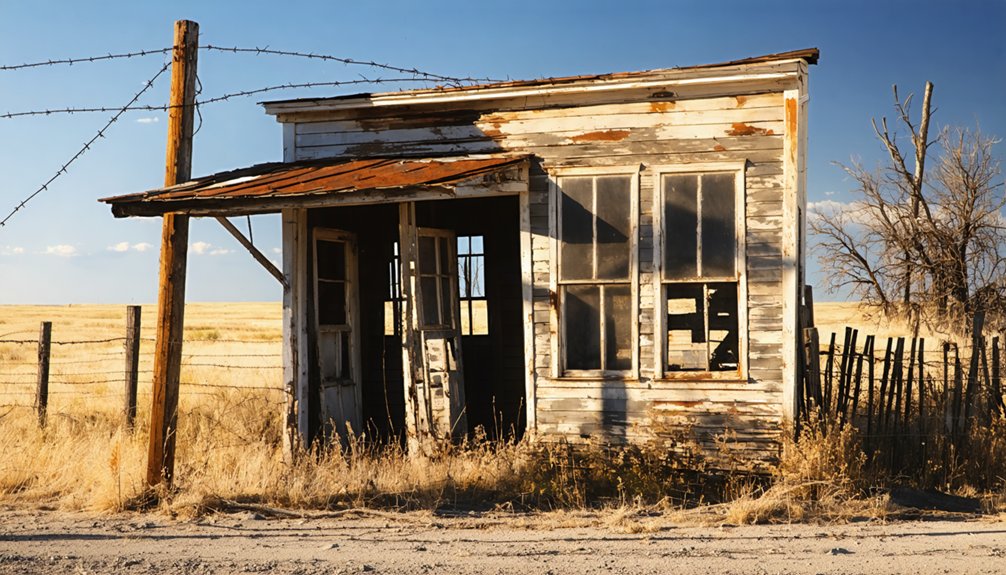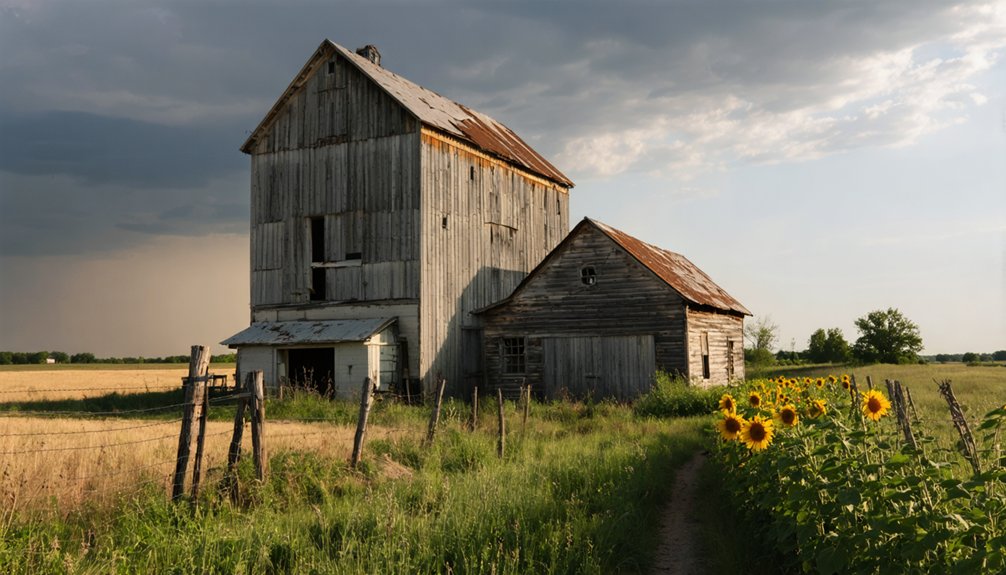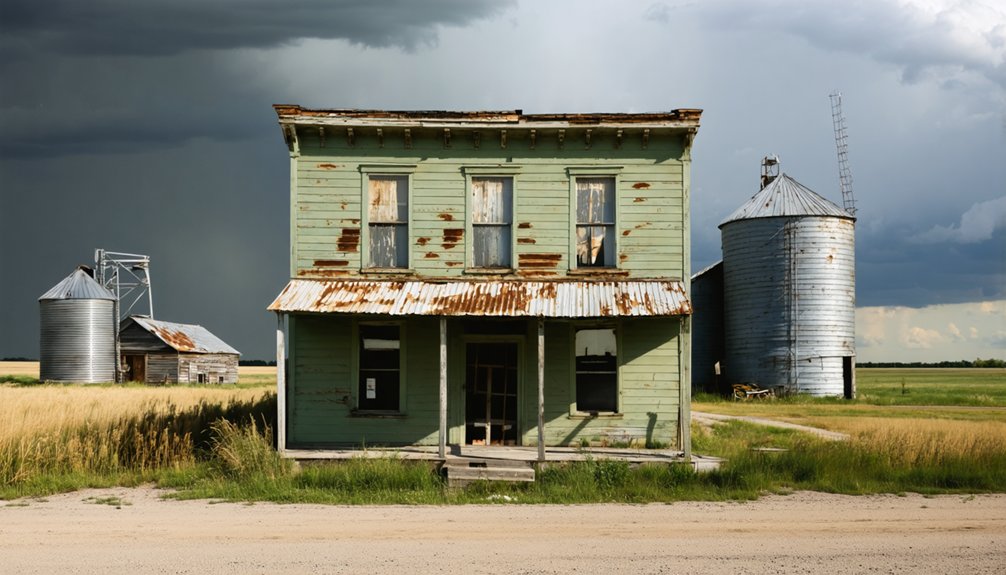You’ll find Lauzon’s ghost town ruins in western South Dakota’s Black Hills region, where this former railroad hub once served the area’s thriving mining operations. During its peak, the town supported several hundred residents with a T-shaped layout of commercial buildings along its main avenue. After losing its sawmill in 1952 and passenger train service in the 1960s, Lauzon’s population dwindled until its abandonment in the 1970s. The remaining chapel ruins and mining infrastructure foundations hold countless untold stories of this boom-and-bust community.
Key Takeaways
- Lauzon was a small rural community in western South Dakota that emerged during mining boom years but never gained formal incorporation status.
- The town’s development was closely tied to the Homestake Mine and Chicago, St. Paul, and Milwaukee Railroad expansion in the 1880s.
- Population declined dramatically between 1900-1970, with the closure of the main sawmill in 1952 marking the beginning of exodus.
- Only skeletal remains of buildings exist today, including chapel ruins and ore processing foundations that showcase the town’s mining heritage.
- The ghost town is now part of heritage tourism routes, though access is limited and requires permission to inspect remaining structures.
Historical Origins and Settlement
Though its exact founding date remains unclear in historical records, Lauzon emerged as a small rural community in western South Dakota, distinct from a mere homestead or ranch.
You’ll find evidence of its settlement patterns in the physical remnants, including a building that settlers later converted to a cow-shed, located a mile and a half southeast of the current structure.
Like many of the ghost town remnants in the Black Hills, careful exploration and documentation help preserve its historical significance.
While Lauzon never gained formal incorporation status or established major institutions like a post office or railroad depot, the community dynamics suggest it was home to multiple families who relied on each other for support.
Despite lacking official recognition, Lauzon’s tight-knit community of homesteaders formed bonds essential for survival in South Dakota’s challenging frontier.
As one of over six hundred ghost towns in the region, Lauzon’s story reflects the broader narrative of small agricultural settlements that briefly dotted western South Dakota’s landscape.
Like many settlements in the area, the town likely faced challenges from harsh winters that contributed to its eventual abandonment.
Life in Early Lauzon
When early settlers arrived in Lauzon, they quickly adapted to the harsh realities of prairie life by constructing dugouts and sod houses from the region’s rich black loam soil. Early settlers commonly faced risks with limited resources and finances.
You’d find Norwegian immigrants forming the backbone of this resilient community, bringing their customs and traditions to the South Dakota prairie. Life centered around agricultural practices, with families working the fertile land to grow grains and raise livestock. The settlers followed patterns similar to the Mound Builders who had inhabited eastern South Dakota centuries before, living in concentrated settlements near water sources.
Due to timber scarcity, you’d have to journey to distant riverbanks for firewood. Community events brought relief from daily toil – dances, holiday celebrations, and church gatherings fostered cultural bonds and mutual support.
The one-room schoolhouse and local church served as crucial social hubs, while the railroad connected you to essential supplies and markets beyond the prairie’s horizon.
Mining and Railroad Influences
You’ll find that Lauzon’s rise was closely tied to the region’s mining boom, which mirrored the success of nearby operations like the Homestake Mine in Lead.
The thriving operation produced 10% of world gold during its 125-year run, showcasing the immense mineral wealth that drove development in towns like Lauzon.
When George Hearst acquired the Homestake claim in 1877, it sparked rapid development throughout the region, including in Lauzon.
The town’s strategic location made it an important railroad hub, connecting mining operations throughout the Black Hills and facilitating the transportation of both ore and essential supplies.
As mining activities in the area began to decline and railroad traffic diminished, Lauzon’s prominence as a transportation center gradually faded.
Mining Operations and Decline
As pioneers flocked to the Black Hills in the late 1870s, placer mining dominated the region’s early mineral extraction efforts, particularly around what would become Lead and Deadwood. Miners initially relied on picks and shovels for basic extraction work before technological advances.
You’ll find that mining technology evolved rapidly as surface deposits depleted, forcing operations to shift to hard rock mining methods.
- The introduction of compressed air locomotives and advanced milling equipment revolutionized mineral extraction efficiency.
- Cyanidization processes improved gold recovery rates, making previously unprofitable deposits viable.
- Environmental impact became increasingly apparent as operations expanded.
- The shift from placer to hard rock mining required substantial capital investment.
The mining industry’s evolution brought both prosperity and challenges to the region, ultimately shaping the fate of towns like Lauzon through cycles of boom and bust as resource availability and extraction methods changed.
Railroad Hub Development
The Chicago, St. Paul, and Milwaukee Railroad’s expansion through southeastern Dakota Territory directly shaped Lauzon’s development in the early 1880s.
You’ll find that railroad insiders strategically controlled townsite establishment in the region, determining where tracks would be laid for maximum profit potential. J.D. Welch and other entrepreneurs anticipated substantial market growth with the railroad’s arrival.
As the Milwaukee Railway extended its reach near Mitchell and south toward present-day Lauzon, it triggered intense competition among planned settlements like Dakota City and Milltown. The community followed a traditional T-shape layout with commercial buildings concentrated along the main avenue perpendicular to the tracks.
You can see how this played out when entire buildings were relocated from Dakota City to railroad-aligned Parkston in 1886. The rail corridors became lifelines for these frontier communities, with initial operations run from converted boxcars serving as temporary depots.
Local bankers and investors, recognizing the railroad’s importance, heavily influenced track placement through their land acquisitions and financial backing.
The Decline Years
You’ll see Lauzon’s most dramatic changes between 1900-1970, as the town’s population steadily decreased from several hundred residents to just a handful of holdouts.
Like many South Dakota towns that lost their passenger train service, Lauzon’s decline became irreversible by the mid-1960s.
The exodus gained momentum after the mines closed and rail service diminished, leaving abandoned storefronts and deteriorating homes in its wake.
Population Exodus Timeline
When Lauzon’s main sawmill shuttered its doors in 1952, the town’s population of roughly 100 residents began its steady march toward extinction.
The population trends showed a rapid decline as families sought work elsewhere, with no alternative industries to sustain the community. Demographic changes accelerated through natural disasters and the withdrawal of essential railroad services.
- By the mid-1960s, only a handful of older residents remained, clinging to their ties to the land.
- The 1970s saw the last permanent families depart, leaving Lauzon largely abandoned.
- Railroad removal in the 1980s sealed the town’s fate, eliminating any chance of economic revival.
- Today, you’ll find only hiking trails where railroads once connected this thriving lumber community to the outside world.
Economic Infrastructure Collapse
Following Lauzon’s population exodus, economic collapse came swiftly as essential infrastructure crumbled throughout the 1950s and 1960s.
You’d have witnessed the stark transformation as rail lines ceased operations, cutting off crucial transportation links that once made Lauzon a bustling hub. The economic isolation hit hard – feed mills closed, grain dealerships shuttered, and the general store’s destruction by fire in 1927 marked a point of no return.
Banking services withdrew, leaving a void in financial operations. Without rail access, you couldn’t effectively transport agricultural products, and farming became increasingly uneconomical.
The commercial decline snowballed as each closure triggered more departures. Schools, post offices, and other institutions vanished, while deteriorating roads and utilities sealed Lauzon’s fate.
Architectural Remnants Today

The skeletal remains of Lauzon’s buildings offer a haunting glimpse into this former Black Hills mining settlement.
You’ll find architectural significance in the weathered foundations and structural remnants that tell the story of this once-bustling town. A structural analysis reveals cellar holes, rubble piles, and discernible door frames scattered across the landscape.
- The chapel ruins stand as the most prominent survivor, its enduring presence a symbol of the community’s religious heritage.
- Mining infrastructure remnants include scattered ore processing foundations and eroded tailings.
- Visible building footprints reveal the town’s original layout and planning methods.
- Foundation stones and industrial remnants show the effects of decades of exposure to harsh Black Hills weather.
Black Hills Ghost Town Legacy
As one of numerous abandoned settlements dotting the Black Hills landscape, Lauzon exemplifies the broader pattern of boom-and-bust mining communities that shaped this region’s identity.
You’ll find its story echoes throughout the Black Hills, where ghost town tourism now helps preserve the mining heritage that defined this rugged territory.
Like many of its contemporaries, Lauzon’s fate was tied to the economic forces that transformed the region – from the 1874 gold rush through the coal mining era and beyond.
Today, you can explore these abandoned places along heritage routes and hiking trails, connecting with tales of pioneer struggles, outlaw legends, and miners’ dreams.
While some towns have vanished completely, others maintain their structural remnants as silent witnesses to the Black Hills’ dynamic past.
Photographic Documentation

Rich photographic documentation of Lauzon reveals a weathered collection of wooden structures and mining remnants set against South Dakota’s expansive plains.
You’ll find various photographic styles capturing the ghost town’s essence, from wide-angle shots emphasizing isolation to intimate close-ups of decaying architectural details.
- Natural lighting techniques showcase texture-rich surfaces of abandoned buildings, including a repurposed cow-shed.
- Interior shots utilize shadow play to create moody narratives within dilapidated structures.
- Historic documentation from the 1970s provides valuable time capsule perspectives.
- Period-dressed subjects add scale and storytelling elements to compositions.
Documentation techniques have preserved Lauzon’s evolution from a bustling mining community to its current state, with images housed in regional archives and digital collections for history enthusiasts and researchers to explore.
Cultural Impact and Heritage
Deeply woven into South Dakota’s cultural fabric, Lauzon’s legacy extends far beyond its physical remains to shape regional identity and folklore.
You’ll find the town’s cultural significance reflected in the broader narrative of Black Hills mining communities, where tales of shadowy figures and unexplained sounds enhance its mystique. The site serves as a powerful educational tool, offering you tangible connections to frontier life through preserved structures like the 1976-documented cow-shed.
Local ghost tours and heritage programs keep Lauzon’s folklore narratives alive, contributing to the region’s tourism economy while preserving essential historical lessons.
Folklore lives on through guided tours of Lauzon, where ghostly tales merge with historical preservation and local economic growth.
Through these stories and sites, you’ll experience how Lauzon exemplifies the boom-and-bust cycles that defined South Dakota’s mining era, connecting you to the resilient spirit of frontier settlers.
Preservation Efforts and Access

While Lauzon’s historical significance remains evident, preservation efforts face substantial challenges due to the site’s remote location and private property restrictions.
You’ll find that community engagement plays an essential role in maintaining what’s left of this historic ghost town, though centralized preservation initiatives are significantly absent.
Current preservation activities include:
- Digital documentation through photographs and historical records to maintain the town’s legacy
- Local historical society involvement in recording and protecting remaining structures
- Community-driven projects that rely on volunteer efforts and regional support
- Collaborative efforts between private landowners and preservation enthusiasts
If you’re planning to visit, you should know that access is limited due to the site’s remote location and infrastructure challenges.
The remaining structures, including the remarkable cowshed, are mostly on private property, requiring permission for closer inspection.
Frequently Asked Questions
Are There Any Reported Paranormal Activities or Ghost Sightings in Lauzon?
You won’t find documented ghost encounters or haunted history at this site – there aren’t any widely reported paranormal activities, though the remote agricultural setting leaves room for unexplored stories.
What Happened to the Personal Belongings Left Behind by Former Residents?
Picture tumbleweed rolling past forgotten memories – you won’t find much proof of abandoned possessions here. Most residents took valuables when leaving, while time and weather claimed whatever remained.
Did Any Notable Historical Figures Ever Visit or Live in Lauzon?
You won’t find any evidence of notable figures in Lauzon’s history. Available records don’t show famous visitors, and the town’s limited documentation suggests it wasn’t a destination for historically significant individuals.
Can Visitors Legally Collect Artifacts or Relics From the Town Site?
Like footprints in fragile sand, you can’t legally take artifacts without proper permissions. Legal regulations protect artifact preservation on both public and private lands, requiring explicit landowner consent.
Were There Any Major Crimes or Significant Law Enforcement Incidents Recorded?
You won’t find recorded major crimes or significant law enforcement incidents in available records. Crime statistics are particularly absent, suggesting the town operated without substantial policing challenges during its brief existence.
References
- https://www.powderhouselodge.com/black-hills-attractions/fun-attractions/ghost-towns-of-western-south-dakota/
- https://www.sdpb.org/rural-life-and-history/2023-08-21/some-black-hills-ghost-towns-and-their-origins
- https://www.youtube.com/watch?v=Glucs_Rq8Xs
- https://www.youtube.com/watch?v=_0WNYsFLSLA
- https://www.sdhspress.com/journal/south-dakota-history-2-2/some-black-hills-ghost-towns-and-their-origins/vol-02-no-2-some-black-hills-ghost-towns-and-their-origins.pdf
- https://www.blackhillsbadlands.com/blog/post/old-west-legends-mines-ghost-towns-route-reimagined/
- https://aberdeenmag.com/2019/01/the-ghost-towns-of-brown-county/
- https://en.wikipedia.org/wiki/List_of_ghost_towns_in_South_Dakota
- https://explore.digitalsd.org/digital/collection/WPGhosttown/id/4270/
- https://adventure.com/usa-americas-forgotten-ghost-towns/



